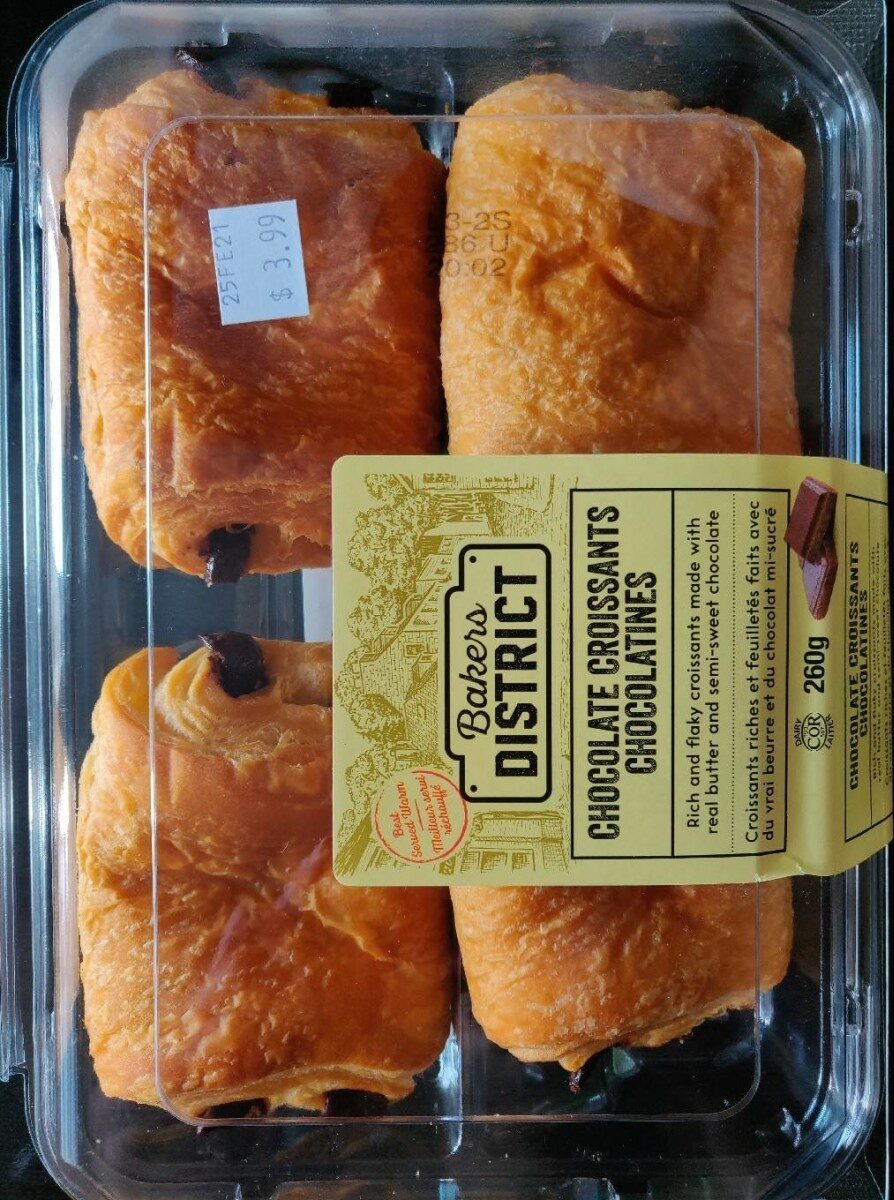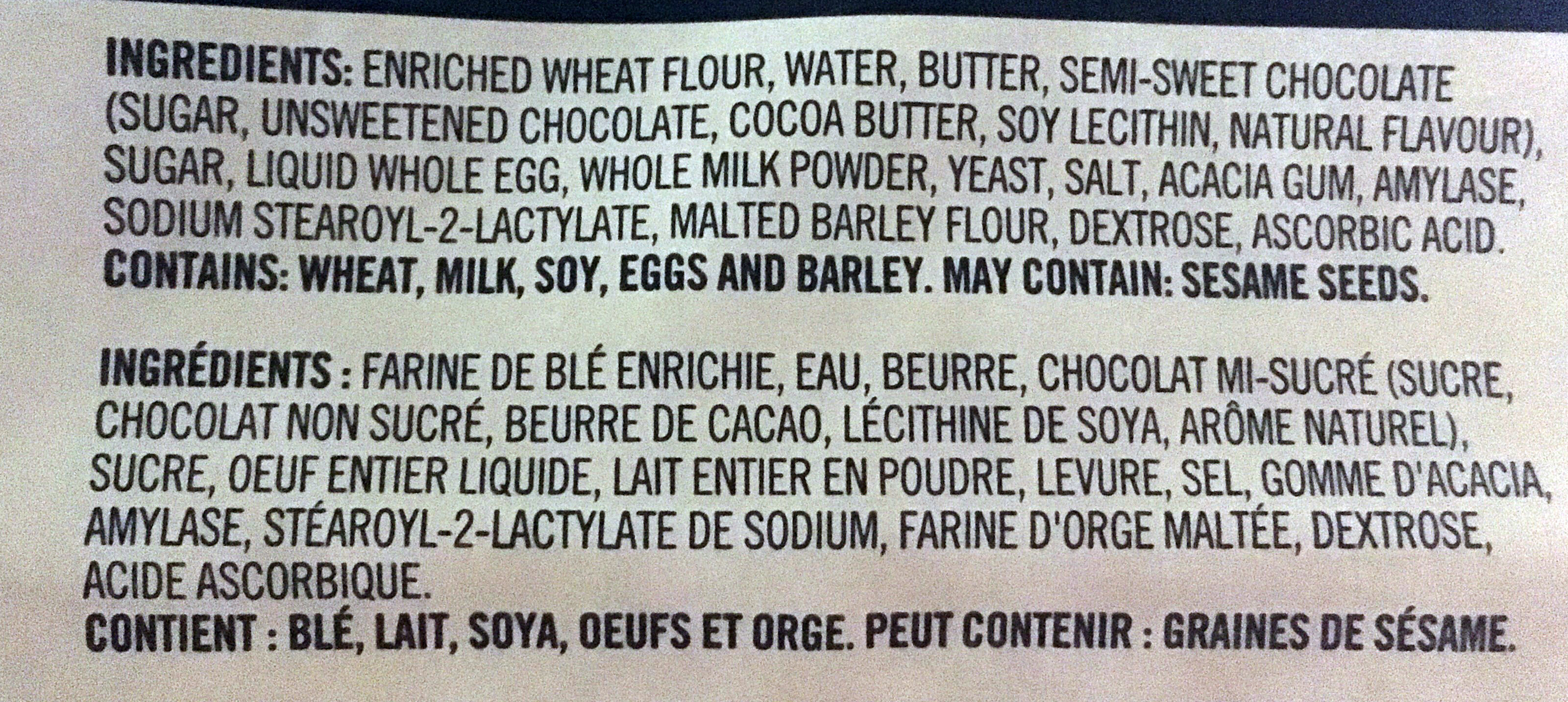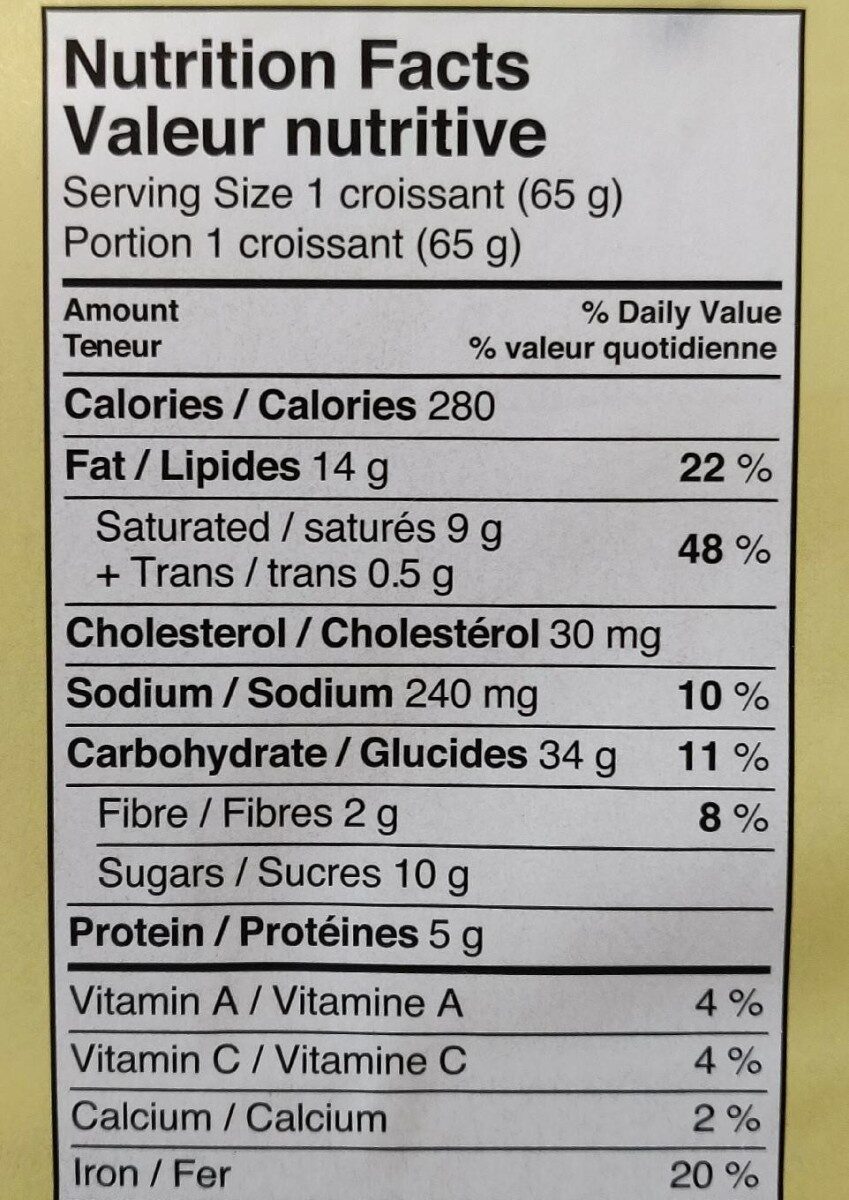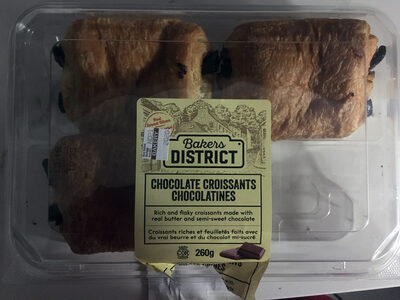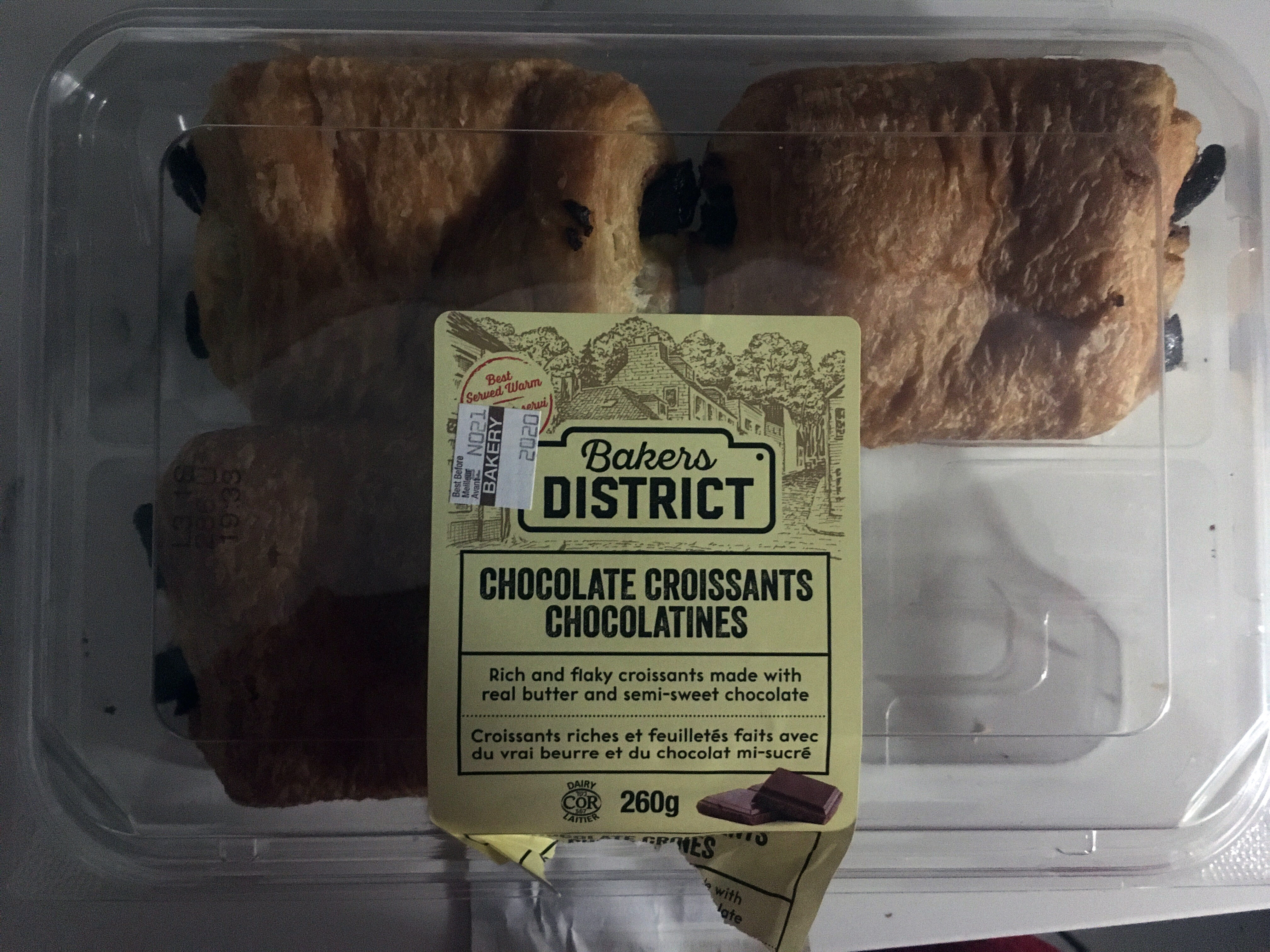Help us make food transparency the norm!
As a non-profit organization, we depend on your donations to continue informing consumers around the world about what they eat.
The food revolution starts with you!
Chocolate Croissants - Bakers District - 260 g
Chocolate Croissants - Bakers District - 260 g
This product page is not complete. You can help to complete it by editing it and adding more data from the photos we have, or by taking more photos using the app for Android or iPhone/iPad. Thank you!
×
Barcode: 0876681078214 (EAN / EAN-13) 876681078214 (UPC / UPC-A)
Common name: Chocolate Croissant
Quantity: 260 g
Packaging: Plastic
Brands: Bakers District, FGF Brands
Categories: Snacks, Sweet snacks, Sweet pastries and pies, Viennoiseries, Croissants, Chocolate croissant
Manufacturing or processing places: 1295 Ormont DriveToronto, ON CanadaM9L 2W6
Link to the product page on the official site of the producer: https://www.fgfbrands.com/
Stores: Food Basics
Countries where sold: Canada
Matching with your preferences
Health
Ingredients
-
20 ingredients
ENRICHED WHEAT FLOUR, WATER, Butter, CHOCOLATE (SUGAR, UNSWEETENED CHOCOLATE, COCOA BUTTER, lecithin, NATURAL FLAVOUR), SUGAR, LIQUID WHOLE EGG, WHOLE MILK POWDER, YEAST, SALT, ACACIA GUM, AMYLASE, SODIUM STEAROYL-2-LACTYLATE, MALTED BARLEY, DEXTROSE, ASCORBIC ACIDAllergens: Eggs, Gluten, Milk, SoybeansTraces: Sesame seeds
Food processing
-
Ultra processed foods
Elements that indicate the product is in the 4 - Ultra processed food and drink products group:
- Additive: E322 - Lecithins
- Additive: E414 - Acacia gum
- Additive: E481 - Sodium stearoyl-2-lactylate
- Ingredient: Dextrose
- Ingredient: Flavouring
- Ingredient: Glucose
Food products are classified into 4 groups according to their degree of processing:
- Unprocessed or minimally processed foods
- Processed culinary ingredients
- Processed foods
- Ultra processed foods
The determination of the group is based on the category of the product and on the ingredients it contains.
Additives
-
E1100 - Alpha-Amylase
Amylase: An amylase -- is an enzyme that catalyses the hydrolysis of starch into sugars. Amylase is present in the saliva of humans and some other mammals, where it begins the chemical process of digestion. Foods that contain large amounts of starch but little sugar, such as rice and potatoes, may acquire a slightly sweet taste as they are chewed because amylase degrades some of their starch into sugar. The pancreas and salivary gland make amylase -alpha amylase- to hydrolyse dietary starch into disaccharides and trisaccharides which are converted by other enzymes to glucose to supply the body with energy. Plants and some bacteria also produce amylase. As diastase, amylase was the first enzyme to be discovered and isolated -by Anselme Payen in 1833-. Specific amylase proteins are designated by different Greek letters. All amylases are glycoside hydrolases and act on α-1‚4-glycosidic bonds.Source: Wikipedia
-
E322 - Lecithins
Lecithins are natural compounds commonly used in the food industry as emulsifiers and stabilizers.
Extracted from sources like soybeans and eggs, lecithins consist of phospholipids that enhance the mixing of oil and water, ensuring smooth textures in various products like chocolates, dressings, and baked goods.
They do not present any known health risks.
-
E322i - Lecithin
Lecithins are natural compounds commonly used in the food industry as emulsifiers and stabilizers.
Extracted from sources like soybeans and eggs, lecithins consist of phospholipids that enhance the mixing of oil and water, ensuring smooth textures in various products like chocolates, dressings, and baked goods.
They do not present any known health risks.
-
E414 - Acacia gum
Gum arabic: Gum arabic, also known as acacia gum, arabic gum, gum acacia, acacia, Senegal gum and Indian gum, and by other names, is a natural gum consisting of the hardened sap of various species of the acacia tree. Originally, gum arabic was collected from Acacia nilotica which was called the "gum arabic tree"; in the present day, gum arabic is collected from acacia species, predominantly Acacia senegal and Vachellia -Acacia- seyal; the term "gum arabic" does not indicate a particular botanical source. In a few cases so‐called "gum arabic" may not even have been collected from Acacia species, but may originate from Combretum, Albizia or some other genus. Producers harvest the gum commercially from wild trees, mostly in Sudan -80%- and throughout the Sahel, from Senegal to Somalia—though it is historically cultivated in Arabia and West Asia. Gum arabic is a complex mixture of glycoproteins and polysaccharides. It is the original source of the sugars arabinose and ribose, both of which were first discovered and isolated from it, and are named after it. Gum arabic is soluble in water. It is edible, and used primarily in the food industry as a stabilizer, with EU E number E414. Gum arabic is a key ingredient in traditional lithography and is used in printing, paint production, glue, cosmetics and various industrial applications, including viscosity control in inks and in textile industries, though less expensive materials compete with it for many of these roles. While gum arabic is now produced throughout the African Sahel, it is still harvested and used in the Middle East.Source: Wikipedia
-
E481 - Sodium stearoyl-2-lactylate
Sodium stearoyl lactylate: Sodium stearoyl-2-lactylate -sodium stearoyl lactylate or SSL- is a versatile, FDA approved food additive used to improve the mix tolerance and volume of processed foods. It is one type of a commercially available lactylate. SSL is non-toxic, biodegradable, and typically manufactured using biorenewable feedstocks. Because SSL is a safe and highly effective food additive, it is used in a wide variety of products ranging from baked goods and desserts to pet foods.As described by the Food Chemicals Codex 7th edition, SSL is a cream-colored powder or brittle solid. SSL is currently manufactured by the esterification of stearic acid with lactic acid and partially neutralized with either food-grade soda ash -sodium carbonate- or caustic soda -concentrated sodium hydroxide-. Commercial grade SSL is a mixture of sodium salts of stearoyl lactylic acids and minor proportions of other sodium salts of related acids. The HLB for SSL is 10-12. SSL is slightly hygroscopic, soluble in ethanol and in hot oil or fat, and dispersible in warm water. These properties are the reason that SSL is an excellent emulsifier for fat-in-water emulsions and can also function as a humectant.Source: Wikipedia
Ingredients analysis
-
May contain palm oil
Ingredients that may contain palm oil: E481
-
Non-vegan
Non-vegan ingredients: Butter, Liquid whole egg, Whole milk powder
-
Maybe vegetarian
Ingredients that may not be vegetarian: E322i, Natural flavouring, E481
-
Details of the analysis of the ingredients
: ENRICHED WHEAT FLOUR, WATER, Butter, CHOCOLATE (SUGAR, CHOCOLATE, COCOA BUTTER, lecithin, NATURAL FLAVOUR), SUGAR, LIQUID WHOLE EGG, WHOLE MILK POWDER, YEAST, SALT, ACACIA GUM, AMYLASE, SODIUM STEAROYL-2-LACTYLATE, MALTED BARLEY, DEXTROSE, ASCORBIC ACID- ENRICHED WHEAT FLOUR -> en:fortified-wheat-flour - vegan: yes - vegetarian: yes - ciqual_proxy_food_code: 9410 - percent_min: 6.66666666666667 - percent_max: 100
- WATER -> en:water - vegan: yes - vegetarian: yes - ciqual_food_code: 18066 - percent_min: 0 - percent_max: 50
- Butter -> en:butter - vegan: no - vegetarian: yes - ciqual_proxy_food_code: 16400 - percent_min: 0 - percent_max: 33.3333333333333
- CHOCOLATE -> en:chocolate - vegan: maybe - vegetarian: yes - percent_min: 0 - percent_max: 25
- SUGAR -> en:sugar - vegan: yes - vegetarian: yes - ciqual_proxy_food_code: 31016 - percent_min: 0 - percent_max: 15.3846
- CHOCOLATE -> en:chocolate - vegan: maybe - vegetarian: yes - percent_min: 0 - percent_max: 12.5
- COCOA BUTTER -> en:cocoa-butter - vegan: yes - vegetarian: yes - ciqual_food_code: 16030 - percent_min: 0 - percent_max: 8.33333333333333
- lecithin -> en:e322i - vegan: maybe - vegetarian: maybe - percent_min: 0 - percent_max: 6.25
- NATURAL FLAVOUR -> en:natural-flavouring - vegan: maybe - vegetarian: maybe - percent_min: 0 - percent_max: 5
- SUGAR -> en:sugar - vegan: yes - vegetarian: yes - ciqual_proxy_food_code: 31016 - percent_min: 0 - percent_max: 15.3846
- LIQUID WHOLE EGG -> en:liquid-whole-egg - vegan: no - vegetarian: yes - ciqual_food_code: 22000 - percent_min: 0 - percent_max: 15.3846
- WHOLE MILK POWDER -> en:whole-milk-powder - vegan: no - vegetarian: yes - ciqual_food_code: 19021 - percent_min: 0 - percent_max: 14.2857142857143
- YEAST -> en:yeast - vegan: yes - vegetarian: yes - percent_min: 0 - percent_max: 12.5
- SALT -> en:salt - vegan: yes - vegetarian: yes - ciqual_food_code: 11058 - percent_min: 0 - percent_max: 0.923077
- ACACIA GUM -> en:e414 - vegan: yes - vegetarian: yes - percent_min: 0 - percent_max: 0.923077
- AMYLASE -> en:e1100 - vegan: yes - vegetarian: yes - percent_min: 0 - percent_max: 0.923077
- SODIUM STEAROYL-2-LACTYLATE -> en:e481 - vegan: maybe - vegetarian: maybe - from_palm_oil: maybe - percent_min: 0 - percent_max: 0.923077
- MALTED BARLEY -> en:malted-barley - vegan: yes - vegetarian: yes - percent_min: 0 - percent_max: 0.923077
- DEXTROSE -> en:dextrose - vegan: yes - vegetarian: yes - ciqual_proxy_food_code: 31016 - percent_min: 0 - percent_max: 0.923077
- ASCORBIC ACID -> en:e300 - vegan: yes - vegetarian: yes - percent_min: 0 - percent_max: 0.923077
Nutrition
-
Bad nutritional quality
⚠ ️Warning: the amount of fruits, vegetables and nuts is not specified on the label, it was estimated from the list of ingredients: 0This product is not considered a beverage for the calculation of the Nutri-Score.
Positive points: 2
- Proteins: 4 / 5 (value: 7.6923, rounded value: 7.69)
- Fiber: 2 / 5 (value: 2, rounded value: 2)
- Fruits, vegetables, nuts, and colza/walnut/olive oils: 0 / 5 (value: 0, rounded value: 0)
Negative points: 22
- Energy: 5 / 10 (value: 1802, rounded value: 1802)
- Sugars: 3 / 10 (value: 15.3846, rounded value: 15.38)
- Saturated fat: 10 / 10 (value: 13.8462, rounded value: 13.8)
- Sodium: 4 / 10 (value: 369.2308, rounded value: 369.2)
The points for proteins are not counted because the negative points are greater or equal to 11.
Nutritional score: (22 - 2)
Nutri-Score:
-
Nutrient levels
-
Fat in high quantity (21.5%)
What you need to know- A high consumption of fat, especially saturated fats, can raise cholesterol, which increases the risk of heart diseases.
Recommendation: Limit the consumption of fat and saturated fat- Choose products with lower fat and saturated fat content.
-
Saturated fat in high quantity (13.8%)
What you need to know- A high consumption of fat, especially saturated fats, can raise cholesterol, which increases the risk of heart diseases.
Recommendation: Limit the consumption of fat and saturated fat- Choose products with lower fat and saturated fat content.
-
Sugars in high quantity (15.4%)
What you need to know- A high consumption of sugar can cause weight gain and tooth decay. It also augments the risk of type 2 diabetes and cardio-vascular diseases.
Recommendation: Limit the consumption of sugar and sugary drinks- Sugary drinks (such as sodas, fruit beverages, and fruit juices and nectars) should be limited as much as possible (no more than 1 glass a day).
- Choose products with lower sugar content and reduce the consumption of products with added sugars.
-
Salt in moderate quantity (0.923%)
What you need to know- A high consumption of salt (or sodium) can cause raised blood pressure, which can increase the risk of heart disease and stroke.
- Many people who have high blood pressure do not know it, as there are often no symptoms.
- Most people consume too much salt (on average 9 to 12 grams per day), around twice the recommended maximum level of intake.
Recommendation: Limit the consumption of salt and salted food- Reduce the quantity of salt used when cooking, and don't salt again at the table.
- Limit the consumption of salty snacks and choose products with lower salt content.
-
-
Nutrition facts
Nutrition facts As sold
for 100 g / 100 mlAs sold
per serving (65 g)Compared to: Chocolate croissant Energy 1,802 kj
(430 kcal)1,170 kj
(280 kcal)+7% Fat 21.538 g 14 g -3% Saturated fat 13.846 g 9 g +4% Trans fat 0.5 g 0.325 g Cholesterol 30 mg 19.5 mg Carbohydrates 52.308 g 34 g +22% Sugars 15.385 g 10 g +23% Fiber 2 g 1.3 g -17% Proteins 7.692 g 5 g +7% Salt 0.923 g 0.6 g +5% Vitamin A 60 µg (4 % DV) 39 µg Vitamin C (ascorbic acid) 2.4 mg (4 % DV) 1.56 mg Calcium 20 mg (2 % DV) 13 mg Iron 3.6 mg (20 % DV) 2.34 mg Fruits‚ vegetables‚ nuts and rapeseed‚ walnut and olive oils (estimate from ingredients list analysis) 0 % 0 %
Environment
-
Eco-Score C - Moderate environmental impact
⚠ ️Select a country in order to include the full impact of transportation.The Eco-Score is an experimental score that summarizes the environmental impacts of food products.→ The Eco-Score was initially developped for France and it is being extended to other European countries. The Eco-Score formula is subject to change as it is regularly improved to make it more precise and better suited to each country.Life cycle analysis
-
Average impact of products of the same category: B (Score: 64/100)
Category: Chocolate croissant, puff pastry, from bakery
Category: Chocolate croissant, puff pastry, from bakery
- PEF environmental score: 0.39 (the lower the score, the lower the impact)
- including impact on climate change: 5.20 kg CO2 eq/kg of product
Stage Impact Agriculture
52.5 %Processing
39.3 %Packaging
4.8 %Transportation
3.3 %Distribution
0.2 %Consumption
0.0 %
Bonuses and maluses
-
Missing origins of ingredients information
Malus: -5
⚠ ️ The origins of the ingredients of this product are not indicated.
If they are indicated on the packaging, you can modify the product sheet and add them.
If you are the manufacturer of this product, you can send us the information with our free platform for producers.
-
Packaging with a medium impact
Malus: -10
Shape Material Recycling Impact Unknown Plastic High ⚠ ️ The information about the packaging of this product is not sufficiently precise (exact shapes and materials of all components of the packaging).⚠ ️ For a more precise calculation of the Eco-Score, you can modify the product page and add them.
If you are the manufacturer of this product, you can send us the information with our free platform for producers.
Eco-Score for this product
-
Impact for this product: C (Score: 49/100)
Product: Chocolate Croissants - Bakers District - 260 g
Life cycle analysis score: 64
Sum of bonuses and maluses: -15
Final score: 49/100
-
Carbon footprint
-
Equal to driving 2.7 km in a petrol car
520 g CO² per 100g of product
The carbon emission figure comes from ADEME's Agribalyse database, for the category: Chocolate croissant, puff pastry, from bakery (Source: ADEME Agribalyse Database)
Stage Impact Agriculture
40.2 %Processing
51.3 %Packaging
5.5 %Transportation
2.9 %Distribution
0.1 %Consumption
0.0 %
Packaging
-
Packaging with a medium impact
-
Packaging parts
(Plastic)
-
Packaging materials
Material % Packaging weight Packaging weight per 100 g of product Plastic
-
Transportation
-
Origins of ingredients
Missing origins of ingredients information
⚠ ️ The origins of the ingredients of this product are not indicated.
If they are indicated on the packaging, you can modify the product sheet and add them.
If you are the manufacturer of this product, you can send us the information with our free platform for producers.Add the origins of ingredients for this product Add the origins of ingredients for this product
Report a problem
-
Incomplete or incorrect information?
Category, labels, ingredients, allergens, nutritional information, photos etc.
If the information does not match the information on the packaging, please complete or correct it. Open Food Facts is a collaborative database, and every contribution is useful for all.
Data sources
Product added on by abidraihan
Last edit of product page on by teolemon.
Product page also edited by kiliweb, packbot, yuka.sY2b0xO6T85zoF3NwEKvlnFkUMrhpmzHNw3jn1DQ_9KLA8D1R9pexKHmNqs.

